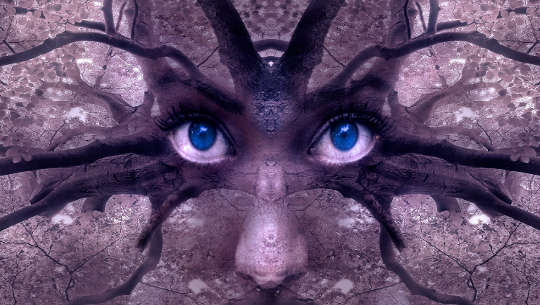
Image by Stefan Keller
The word “horror” is derived from the Latin verb horrere, which means “to shudder.” Evil is an integral part of any horror film. This evil is channeled through “a human, creature, or supernatural force” (Martin, 2019). Flesh-eating zombies, vampires, chainsaw-welding serial killers, murderous psychopaths, and insane demons are repeatedly harbingers of evil in these stories (Clasen, 2012). But how do on-screen monsters trigger our primitive fear responses when we are aware of our safety? And why do some of us enjoy and seek the feeling of shuddering?
Fear is a subjective experience
Fear is a subjective experience that is evolutionarily based on promoting survival. Your brain is constantly scanning the environment for threats, which are rated based on predicted proximity, likelihood, and severity (Mobbs et al., 2007; Rigoli et al., 2016). The fear response is refereed by a complex and brain-wide network. When a threat is sensed by visual, somatosensory, or olfactory cortices, the autonomic nervous system triggers a “fight-or-flight” response in less than half a second. The proximity of the threat is the key determinant of which brain regions and components of the fear circuit control behavioral responses (Mobbs et al., 2007; Rigoli et al., 2016).
When a threat is sensed by visual, somatosensory, or olfactory cortices, the autonomic nervous system triggers a “fight-or-flight” response in less than half a second.
The frontal cortices (especially the orbitofrontal and medial prefrontal cortices) and the amygdala together create the conscious experience of fear (Adolphs, 2013; Giustino and Maren, 2015; Tovote et al., 2015). When a threat is far away, the frontal cortex (the planning and strategizing center of the brain) is in charge. The frontal cortex controls the brainstorming of escape routes or avoidance techniques (Giustino and Maren, 2015). Frontal structures also mitigate fear-induced emotional responses by inhibiting the activation of the amygdala (Mobbs et al., 2007; Feinstein et al., 2011). As soon as the threat is imminent, frontal regulation collapses and the amygdala takes over (Feinstein et al., 2011; Zheng et al., 2017).
The amygdala is the brain’s fear center. It enables one to learn, express, and recognize fear. It also acts as an intermediary between the most sophisticated and most primitive structures of the brain – which together make up the fear circuit (Feinstein et al., 2011; Zheng et al., 2017). When a situation is perceived as frightening or threatening, the amygdala activates the hypothalamic-pituitary-adrenal axis to initiate a global, multifaceted autonomic fear response (Adolphs, 2013). For example, the anterior pituitary releases corticotropin-releasing factor (CRF), which stimulates the subsequent release of adrenaline and cortisol (Adolphs, 2013). These and other phenomena, all of which have multiple effects on different organs, stimulate the cardiovascular, skeletal, and endocrine systems to refocus attention, prepare muscles, heighten awareness, and unlock long-term memories necessary for survival .
Since threatening stimuli can signal potential injury, illness, or even death, our brains are hardwired to be hyperresponsive and err on the side of caution (Adolphs, 2013). Direct recordings from the amygdala show that it responds to fear-inducing information in less than 120 milliseconds, much faster than the rate at which our prefrontal cortices can evaluate contextual information (Zheng et al., 2017). Even when viewing the Psycho shower scene from the safety of a couch, the jarring violin, high-pitched screams, and bloody imagery create an all-encompassing fear response that bypasses the brain’s “reality checking systems” (Feinstein et al., 2011; Adolphs, 2013; Giustino and Maren, 2015). This is true even if you start John Carpenter’s Halloween knowing that Michael Myers, a masked psychopath, is within the confines of your television or theater projection screen. As soon as Michael enters his first victim’s kitchen and grabs a chef’s knife, this neural cascade is initiated. Contextual clues and top-down emotion regulation strategies only partially suppress your full-blown autonomic response while waiting for the next murder. Executive control systems eventually take over, and finally recall the memories and contextual notices that confirm your safety.
Like the famous case of Patient S. M. shows, neurological patients with damage to the amygdala no longer recognize fearful facial expressions and gestures in others or experience fear themselves (Feinstein et al., 2011). Due to Urbach–Wiethe disease, S. M. had localized, bilateral amygdala damage, which abolished her ability to experience fear in the most harrowing, dangerous situations – like handling a venomous snake (Feinstein et al., 2011). There is an abundance of literature on fear acquisition, the process by which fear is learned. Less is known about how fear is extinguished, i.e., the gradual decrease in a learned fear response. Fear extinction likely involves many of the same areas of the brain as fear acquisition and may be accomplished by inhibiting the fear circuits described above.
Why we enjoy horror films
The amygdala is consistently activated when watching horror films, and its activation is proportional to the subjective fear experienced by the horror film viewer (Kinreich et al., 2011). When watching a film in the semi-darkness of a cinema, the audience shares the collective experience of dread in a time-locked, harmonized fashion. In a functional imaging study of fear responses to The Conjuring 2, activation of the sensory cortex and fear circuitry was synchronized in time between viewers, with the greatest activation during sudden “jump scares” (Hudson et al., 2020).
The more immersive the film with less contextual cues, the more intense the reaction (Martin, 2019). The plot of Halloween begins like a documentary, with the date and location given just before the first-person view of Michael Myers’ inaugural murder. Cinematographic tools like these make the experience more intimate and terrifying for the viewer. Some films have even falsely led audiences to believe that the footage is a true report rather than a powerful cinematic device. Toby Hooper’s The Texas Chainsaw Massacre (1974) began with a disclaimer about the true nature of events in the film, as well as when and where those events took place. Although the sadistic plot was loosely inspired by the real-life crimes of Ed Gein, Leatherface and his family were otherwise fictional. These opening lines, while untrue, held the audience in suspense and added to the shock when they first saw the film.
Greater empathy and personal suffering are negatively associated with horror film enjoyment, while high levels of psychopathy are associated with greater enjoyment of violent, bloody horror films (Martin, 2019). In addition, substantially more men than women watch and enjoy horror films (Martin, 2019). These sex differences can be due to many factors, such as sex differences in the socialization of aggression and violence, or a higher sensitivity to disgust in women (Martin, 2019).
The viewing experience is central to whether or not horror films are enjoyed. As social beings, we naturally reflect the fear reactions and physical states of horror film protagonists (Wicker et al., 2003; Nummenmaa et al., 2012). The vicarious experience relies on the viewer’s ability to empathize and resonate with vulnerable but inspiring characters like Carl Grimes in The Walking Dead. When these characters defeat or temporarily stop the villain, the enjoyment of the movie or show is increased (Hoffner, 2009).
Despite these general trends, the data are inconsistent. Of the empirical studies that have examined the relationship between individual characteristics and horror enjoyment, only a few have achieved a sufficient sample size or used generalizable film content (Martin, 2019). Some used slasher films, others used films about paranormal entities. Any empirical study of horror films is therefore limited by the inability to rigorously control the type, content, and length of the film(s) used to measure horror film enjoyment. Individual differences also affect horror movie enjoyment, since profession influences the horrors that each individual experiences on a regular basis (Vlahou et al., 2011). For example, nursing students exposed to videos of graphic medical procedures are more likely to show sadness than fear (Vlahou et al., 2011).
Mark Zuckerman’s sensation-seeking theory is one of the main theories used to explain interest in the horror film industry (Martin, 2019). Sensation seeking, also known as thrill or excitement seeking, is the tendency to pursue new and different sensations, feelings, and experiences. According to Zuckerman, people looking for high sensation are more likely to be drawn to horror films (Martin, 2019). This attraction is powered by the fact that horror films offer us thrills and adventure when we experience the macabre from a safe environment (Martin, 2019). Results from studies of brain imaging show that anticipating fearful situations appeals to the brain’s pleasure and reward processing centers in the ventral striatum (Klucken et al., 2009). Since this only applies to predictable threats, the data suggest that the fear evoked by horror movies must be predictable in order to be fun (Klucken et al., 2009).
According to Zuckerman, people looking for high sensation are more likely to be drawn to horror films.
The only thing all horror films have in common is their exploitation of our fear of the unknown, the most universal human fear of time and space (Carleton, 2016). Why is darkness scary? Because we don’t know what’s lurking, whether we’re looking into a hedge labyrinth in The Shining or the emptiness of Hannibal Lecter’s eyes. As explained by Shepard (1997), “[o]ur fear of monsters in the night probably has its origins far back in the evolution of our primate ancestors, whose tribes were pruned by horrors whose shadows continue to elicit our monkey screams in dark theaters.” Despite our fear of the unknown, horror films provide a safe intellectual playground for our fascination with the unusual or dangerous. These experiences provide a framework for experiencing stressors and building resilience in preparation for real threats (Carleton, 2016; Clasen, 2012). From our living room or theater seats, we can immerse ourselves in exciting, life-threatening content and prepare for unfortunate events that better prepare us for disasters in real life.
In addition to being psychologically beneficial, horror films have practical uses that go beyond simple entertainment Terrifying, fictional creatures like zombies can be important teaching tools for learning neuroscience. This is the aim of the book Do Zombies Dream of Undead Sheep? A Neuroscientific View of the Zombie Brain. Do you know which regions of the brain would have to be damaged to create a zombie? By considering the deficits and injuries that would be required to create zombie or zombie-like state, neuroscientists Bradley Voytek and Timothy Verstynen teach the anatomy of the brain and the functions of its many parts. If you’d like to learn more about their book and the colorful adventures involved in its inception, check out the Knowing Neurons podcast episode from October 2021.
About The Author
Arielle Hogan received a B.S. in Biology and a B.A. in French from the University of Virginia. She is now pursuing a Ph.D. in Neuroscience in the NSIDP program at UCLA. Her research focuses on CNS injury and neural repair.

Books Improving Attitude and Behavior from Amazon's Best Sellers list
"Atomic Habits: An Easy & Proven Way to Build Good Habits & Break Bad Ones"
by James Clear
In this book, James Clear presents a comprehensive guide to building good habits and breaking bad ones. The book includes practical advice and strategies for creating lasting behavior change, based on the latest research in psychology and neuroscience.
Click for more info or to order
"Unf*ck Your Brain: Using Science to Get Over Anxiety, Depression, Anger, Freak-Outs, and Triggers"
by Faith G. Harper, PhD, LPC-S, ACS, ACN
In this book, Dr. Faith Harper offers a guide to understanding and managing common emotional and behavioral issues, including anxiety, depression, and anger. The book includes information on the science behind these issues, as well as practical advice and exercises for coping and healing.
Click for more info or to order
"The Power of Habit: Why We Do What We Do in Life and Business"
by Charles Duhigg
In this book, Charles Duhigg explores the science of habit formation and how habits impact our lives, both personally and professionally. The book includes stories of individuals and organizations who have successfully changed their habits, as well as practical advice for creating lasting behavior change.
Click for more info or to order
"Tiny Habits: The Small Changes That Change Everything"
by BJ Fogg
In this book, BJ Fogg presents a guide to creating lasting behavior change through small, incremental habits. The book includes practical advice and strategies for identifying and implementing tiny habits that can lead to big changes over time.
Click for more info or to order
"The 5 AM Club: Own Your Morning, Elevate Your Life"
by Robin Sharma
In this book, Robin Sharma presents a guide to maximizing your productivity and potential by starting your day early. The book includes practical advice and strategies for creating a morning routine that supports your goals and values, as well as inspiring stories of individuals who have transformed their lives through early rising.
Click for more info or to order
References:
Adolphs, R. (2013). The Biology of Fear. Curr. Biol. 23, R79. doi:10.1016/J.CUB.2012.11.055.
Carleton, R. N. (2016). Fear of the unknown: One fear to rule them all? J. Anxiety Disord. 41, 5–21. doi:10.1016/J.JANXDIS.2016.03.011.
Clasen, M. (2012). Monsters Evolve: A Biocultural Approach to Horror Stories: https://doi.org/10.1037/a0027918 16, 222–229. doi:10.1037/A0027918.
Feinstein, J. S., Adolphs, R., Damasio, A., and Tranel, D. (2011). The human amygdala and the induction and experience of fear. Curr. Biol. 21, 34–38. doi:10.1016/J.CUB.2010.11.042.
Giustino, T. F., and Maren, S. (2015). The Role of the Medial Prefrontal Cortex in the Conditioning and Extinction of Fear. Front. Behav. Neurosci. 0, 298. doi:10.3389/FNBEH.2015.00298.
Hoffner, C. (2009). Affective responses and exposure to frightening films: The role of empathy and different types of content. Commun. Res. Reports 26, 285–296. doi:10.1080/08824090903293700.
Hudson, M., Seppälä, K., Putkinen, V., Sun, L., Glerean, E., Karjalainen, T., et al. (2020). Dissociable neural systems for unconditioned acute and sustained fear. Neuroimage 216, 116522. doi:10.1016/J.NEUROIMAGE.2020.116522.
Kinreich, S., Intrator, N., and Hendler, T. (2011). Functional Cliques in the Amygdala and Related Brain Networks Driven by Fear Assessment Acquired During Movie Viewing. Brain Connect. 1, 484–495. doi:10.1089/BRAIN.2011.0061.
Klucken, T., Tabbert, K., Schweckendiek, J., Merz, C., Kagerer, S., Vaitl, D., et al. (2009). Contingency learning in human fear conditioning involves the ventral striatum. Hum. Brain Mapp. 30, 3636–3644. doi:10.1002/HBM.20791.
Martin, G. N. (2019). (Why) Do You Like Scary Movies? A Review of the Empirical Research on Psychological Responses to Horror Films. Front. Psychol. 0, 2298. doi:10.3389/FPSYG.2019.02298.
Mobbs, D., Petrovic, P., Marchant, J. L., Hassabis, D., Weiskopf, N., Seymour, B., et al. (2007). When Fear Is Near: Threat Imminence Elicits Prefrontal-Periaqueductal Gray Shifts in Humans. Science (80-. ). 317, 1079–1083. doi:10.1126/SCIENCE.1144298.
Nummenmaa, L., Glerean, E., Viinikainen, M., Jääskeläinen, I. P., Hari, R., and Sams, M. (2012). Emotions promote social interaction by synchronizing brain activity across individuals. Proc. Natl. Acad. Sci. 109, 9599–9604. doi:10.1073/PNAS.1206095109.
Rigoli, F., Ewbank, M., Dalgleish, T., and Calder, A. (2016). Threat visibility modulates the defensive brain circuit underlying fear and anxiety. Neurosci. Lett. 612, 7–13. doi:10.1016/J.NEULET.2015.11.026.
Shepard, P. (1997). The others?: how animals made us human. 1st pbk. ed. Washington D.C.: Island Press.
Tovote, P., Fadok, J., and Lüthi, A. (2015). Neuronal circuits for fear and anxiety. Nat. Rev. Neurosci. 16, 317–331. doi:10.1038/NRN3945.
Vlahou, C. H., Vanman, E. J., And Morris, M. M. (2011). Emotional Reactions While Watching Graphic Medical Procedures: Vocational Differences in the Explicit Regulation of Emotions1. J. Appl. Soc. Psychol. 41, 2768–2784. doi:10.1111/J.1559-1816.2011.00839.X.
Wicker, B., Keysers, C., Plailly, J., Royet, J., Gallese, V., and Rizzolatti, G. (2003). Both of us disgusted in My insula: the common neural basis of seeing and feeling disgust. Neuron 40, 655–664. doi:10.1016/S0896-6273(03)00679-2.
Zheng, J., Anderson, K. L., Leal, S. L., Shestyuk, A., Gulsen, G., Mnatsakanyan, L., et al. (2017). Amygdala-hippocampal dynamics during salient information processing. Nat. Commun. 2017 81 8, 1–11. doi:10.1038/ncomms14413.
This article originally appeared on Knowing Neurons





















